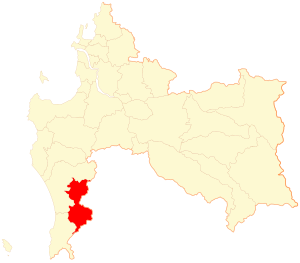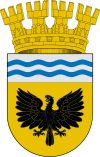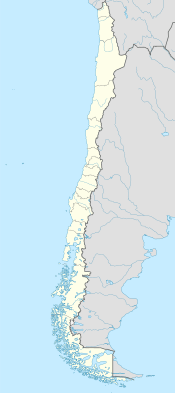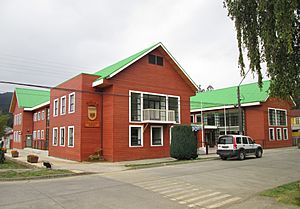Contulmo facts for kids
Quick facts for kids
Contulmo
|
||
|---|---|---|
|
Town and Commune
|
||
|
||

Map of the Contulmo commune in the Biobío Region
|
||
| Country | Chile | |
| Region | Biobío Region | |
| Province | Arauco Province | |
| Government | ||
| • Type | Municipality | |
| Area | ||
| • Total | 961.5 km2 (371.2 sq mi) | |
| Elevation | 25 m (82 ft) | |
| Population
(2012 Census)
|
||
| • Total | 5,515 | |
| • Density | 5.7358/km2 (14.8557/sq mi) | |
| • Urban | 2,442 | |
| • Rural | 3,396 | |
| Sex | ||
| • Men | 3,020 | |
| • Women | 2,818 | |
| Time zone | UTC-4 (CLT) | |
| • Summer (DST) | UTC-3 (CLST) | |
| Area code(s) | country 56 + city 41 | |
| Website | Municipality of Contulmo | |
Contulmo is a small Chilean town and commune in the Arauco Province, which is part of the Biobío Region. Its name comes from the Mapudungun language, meaning "place of transit." This town was settled by German families from Berlin starting in 1884.
Contents
History of Contulmo
Early History and the Mapuche People
In December 1612, a sad event happened near Contulmo. Three Jesuit missionaries and five Mapuche leaders were killed by a Mapuche leader named Anganamón. This happened because he was angry about some of his wives leaving him. This event was important because it marked the end of a military plan called the "Defensive War" during the Arauco War. This war was a long conflict between the Spanish Empire and the Mapuche people in these lands.
German Settlers Arrive
In 1884, a group of 48 Protestant German families decided to leave their homes in Berlin, Germany. They wanted to start a new life in Southern Chile, in a historical area called Araucanía. A German missionary named Oskar von Barchwitz-Krauser helped gather these families. He wanted to create a community based on Christian values.
The journey was long! The settlers traveled from Berlin to Hamburg, then sailed to Liverpool. After a stop in Rio de Janeiro, they sailed through the Strait of Magellan and finally reached the Chilean port of Talcahuano in April 1884.
When they arrived, building a town was very hard. Contulmo is in the middle of the Coastal mountain range, and the area had thick swamps and dense forests. Despite the challenges, they built their new home. The first elected mayor of Contulmo was a German who became a Chilean citizen, Paul Kortwich, in 1918.
Geography of Contulmo
Contulmo covers an area of about 961.5 square kilometers. It shares borders with other towns:
- To the north and northwest: Cañete
- To the southwest: Tirúa
- To the east: Purén
- To the southeast: Lumaco
The commune of Contulmo includes parts of two beautiful lakes: Lanalhue and Lleulleu. The town itself is surrounded by the mountains and hills of the Nahuelbuta Range.
Population of Contulmo
According to a census taken in 2002, Contulmo had 5,838 people living there.
- 3,020 were men.
- 2,818 were women.
About 2,442 people (41.8%) lived in urban areas, which means in the town itself. The other 3,396 people (58.2%) lived in rural areas, which are the countryside parts of the commune. Between 1992 and 2002, the population of Contulmo decreased by about 13.3%.
Culture in Contulmo
Contulmo's culture shows a strong influence from its German settlers. You can see this in the town's buildings and how it's designed.
The town celebrates its heritage with special events:
- "Fest der Kolonisten": This means "feast of the colonists" in German. It's celebrated every year in April to remember the first settlers.
- "Feast of the White Strawberry": This festival takes place in December.
These events help keep the unique traditions of Contulmo alive!
How Contulmo is Governed
Contulmo is a commune, which is like a local government area in Chile. It is managed by a municipal council. The head of the council is an alcalde, which is like a mayor. The alcalde is chosen by the people in an election every four years.
The current alcalde of Contulmo is Eduardo Aguayo Thiele. He is part of the UDI political party.
Climate in Contulmo
Contulmo has a mild climate. Here's a quick look at the weather:
| Climate data for Contulmo | |||||||||||||
|---|---|---|---|---|---|---|---|---|---|---|---|---|---|
| Month | Jan | Feb | Mar | Apr | May | Jun | Jul | Aug | Sep | Oct | Nov | Dec | Year |
| Mean daily maximum °C (°F) | 26.1 (79.0) |
25.7 (78.3) |
23.6 (74.5) |
20.1 (68.2) |
16.0 (60.8) |
13.6 (56.5) |
13.7 (56.7) |
15.6 (60.1) |
17.2 (63.0) |
19.6 (67.3) |
21.5 (70.7) |
23.8 (74.8) |
19.7 (67.5) |
| Daily mean °C (°F) | 17.1 (62.8) |
16.6 (61.9) |
15.0 (59.0) |
12.9 (55.2) |
10.7 (51.3) |
9.1 (48.4) |
8.9 (48.0) |
9.3 (48.7) |
10.3 (50.5) |
12.2 (54.0) |
13.9 (57.0) |
15.7 (60.3) |
12.6 (54.8) |
| Mean daily minimum °C (°F) | 9.8 (49.6) |
9.7 (49.5) |
8.8 (47.8) |
7.6 (45.7) |
6.3 (43.3) |
5.3 (41.5) |
5.0 (41.0) |
4.8 (40.6) |
5.5 (41.9) |
6.5 (43.7) |
7.8 (46.0) |
9.0 (48.2) |
7.2 (44.9) |
| Average precipitation mm (inches) | 38.1 (1.50) |
42.8 (1.69) |
85.5 (3.37) |
142.6 (5.61) |
294.7 (11.60) |
331.1 (13.04) |
308.4 (12.14) |
239.2 (9.42) |
161.7 (6.37) |
91.6 (3.61) |
98.5 (3.88) |
61.9 (2.44) |
1,896.1 (74.67) |
| Average relative humidity (%) | 76 | 78 | 81 | 84 | 86 | 87 | 86 | 84 | 82 | 81 | 79 | 77 | 82 |
| Source: Bioclimatografia de Chile | |||||||||||||
See also
 In Spanish: Contulmo para niños
In Spanish: Contulmo para niños




